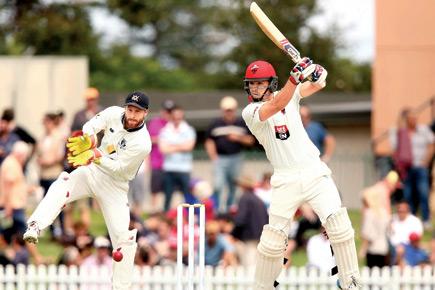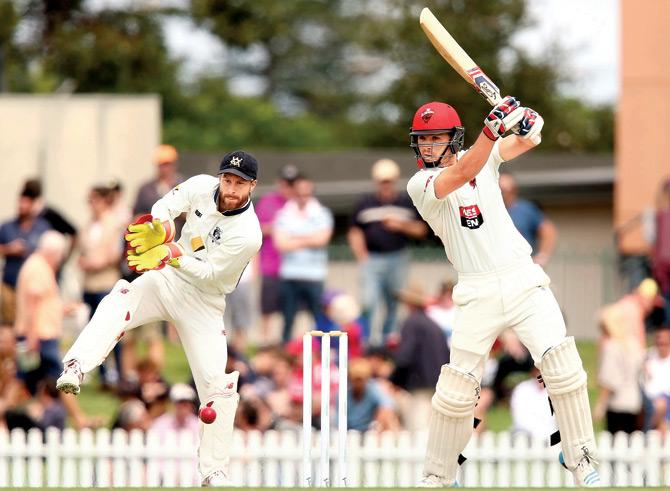International cricket was the lifeblood of the game until the advent of T20 leagues in general and the Indian Premier League in particular

South Australia's Sam Raphael plays a shot as Victoria's Matthew Wade looks on during the Sheffield Shield final in March. Pic/Getty Images
 International cricket was the lifeblood of the game until the advent of T20 leagues in general and the Indian Premier League in particular.
International cricket was the lifeblood of the game until the advent of T20 leagues in general and the Indian Premier League in particular.
Both Test and limited overs cricket have been left in the wake of T20’s rapid expansion and this is obviously now concerning the game’s administrators.
ADVERTISEMENT
In recent times, there’s been a huge push for day-night Tests and now there’s talk of improving payments so the best players are available for their national side rather than performing as T20 mercenaries. The irony of Cricket Australia being behind the push for improved pay, when not so long ago they were part of ‘The Big Three’s’ grab for a larger slice of the international money pot, wouldn’t be lost on those who would’ve suffered under that aborted scheme.

South Australia's Sam Raphael plays a shot as Victoria's Matthew Wade looks on during the Sheffield Shield final in March. Pic/Getty Images
Any moves to promote international cricket are welcome and this should include plans to hold a World Test championship.
However, one thing that acts as an anchor dragging on the popularity of Test cricket, is the number of one-sided contests. One way to reduce this flaw is to upgrade the standard of first-class cricket in the struggling Test playing nations.
It’s no coincidence that the teams with the strongest first-class competitions are also the best Test match sides.
There’s no better example of this disparity than in the current West Indies side, where they have some talented players but not many who are well-versed in the art of competing, either with bat or ball, over a long period.
It takes talent as well as skills honed over time to succeed as a Test player. In addition, there’s knowing how to compete for five days; for a batsman it’s how to construct an innings to make big scores whilst for a trundler it’s bowling well for a complete spell and not wilting under attack. These aspects of the game are best learned in the heat of a hard-fought first-class contest.
Tough for Sobers
After playing for South Australia in the Sheffield Shield competition Garry Sobers observed: “This is the hardest cricket I’ve played outside the Test arena.”
Despite this competition being diluted with internationals only making rare appearances, it’s probably true to say that on occasions, the Australian players find Test matches easier than Shield cricket. The strongest first-class competitions are in Australia, India, England and South Africa. If India adopted an elite first-class competition where the best players fought it out utilising fewer teams along with a second tier level to keep the production line strong, they would take some beating in the Test arena.
Think again
The problems for some of the other Test playing teams are many and varied; from the West Indies need to improve pitches and find a way to have their best players competing, to South Africa overcoming the quota system and Pakistan’s security issues.
Nevertheless, little can be done to improve flailing first-class competitions until cricket’s scheduling is rationalised. If Test cricket is to regain some of its lost prestige, it’s going need a major re-think in the way the different competitions are treated. Instead of T20 tournaments expanding at the expense of first-class competitions, their popularity needs to finance improvements in the longer game.
This way T20 won’t suffer from over-kill and players will have the chance to develop their all-round skills, so that artistry isn’t lost to the game with a surge in power cricketers. The need to retain some artistry in the game is evident in the way batting is viewed differently from one form of cricket to another. If a player backs away in T20, it’s classed as innovative in order to make room to hit over the off-side, whilst a batsman retreating in a Test match would be labelled as scared. T20 has done much to enhance the game but it’s success needs to be kept in perspective.
Cricket won’t survive the long haul with T20 as a standalone entity, it also needs to embrace the artistry and nuances provided by the longer formats.
 Subscribe today by clicking the link and stay updated with the latest news!" Click here!
Subscribe today by clicking the link and stay updated with the latest news!" Click here!







